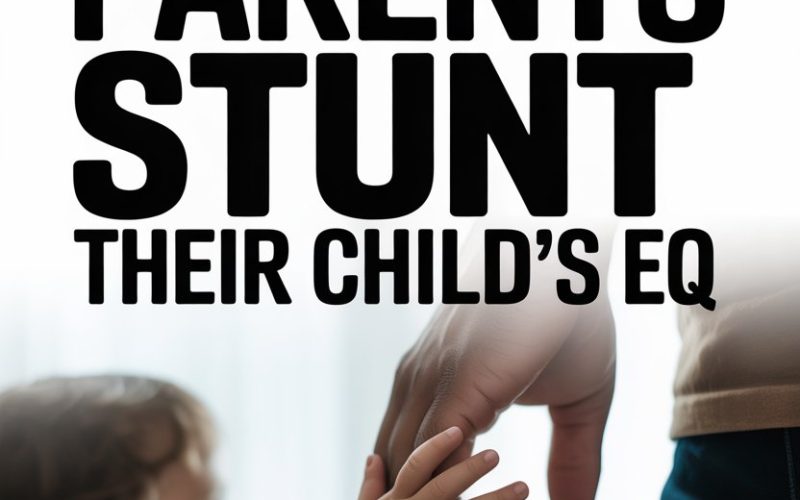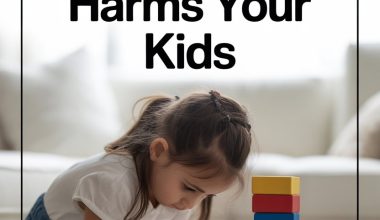Blink and you’ve missed it: another day tripping over laundry baskets, negotiating dinnertime, and half-watching your child stage a three-act drama over the wrong-coloured cup.
You’re doing all the right things—so why does your child’s emotional intelligence (EQ) seem stuck in second gear?
It’s not the splashy mistakes that hold kids back.
It’s the quiet ones. The background noise. The things we don’t even realize we do.
What Is EQ, and Why Should You Care?
Emotional intelligence isn’t just a buzzword tossed around at corporate retreats. It’s the secret sauce behind resilience, good relationships, and that rare ability to handle a toddler tantrum without needing your own time-out.
Research shows children with higher EQ tend to have better academic performance, stronger friendships, and fewer behaviour issues.
We all want our kids to be academically sharp, but what about being able to name their feelings, handle frustration, and bounce back after a tough day? That’s EQ territory.
Problem is, many perfectly caring, loving parents are unwittingly clipping their children’s emotional wings.
The Quiet Offenders: How We Stunt EQ Without Realising
It’s not yelling or outright neglect tripping kids up, though both can cause plenty of trouble.
It’s subtler. It’s the daily patterns—the invisible ways we miss chances to help our children tune into their feelings and the world around them.
Ready for some honest self-reflection (possibly with a side of self-deprecating humour and strong tea)?
Brushing Off Big Feelings
You’re in the supermarket, your child’s bottom lip starts to wobble, and before you know it you’re in the middle of a wailing session over biscuits. The urge to mutter, “You’re fine, stop fussing,” is strong.
After all, you ARE late, and you ARE being judged by the pensioner in aisle four.
Trouble is, when we gloss over big feelings with hurried reassurances or dismissals—“You’ll be OK, don’t cry,” or “There’s nothing to be scared of”—kids don’t learn to name what’s happening inside.
Instead, they learn that certain emotions are off-limits.
Research shows that acknowledging emotions (even ones you’d love to fast-forward) is key to building EQ.
Try, “Looks like you’re really sad we can’t get those biscuits. That’s disappointing.” Suddenly your child isn’t alone with their giant feelings.
Solving Instead of Listening
Ever find yourself jumping in with solutions before your child’s finished their sentence? “Oh, you dropped your toy? Here, let’s play with this one instead!”
Sometimes we treat emotions like spilled juice—mop it up quick, problem solved.
But emotional messes aren’t meant to be fixed straight away. Kids need to sit with feelings, chew them over, and—ideally—work out their own path forward.
It’s not about leaving them to stew but showing you trust them to process and find words.
Research suggests parents who ask guiding questions and reflect feelings back (“That must have been frustrating”) raise children who are more able to self-soothe and problem-solve. Hard as it is, try pausing before leaping in with a fix.
Minimising or Mocking Emotions
“Don’t be such a baby,” “Toughen up,” or even a gently mocking “Oh, you poor thing”—these phrases slip out when patience is thin.
Maybe they were said to you as a child, handed down like awkward family heirlooms.
The issue? Kids pick up the message fast: Some feelings are embarrassing, and best hidden. That’s a recipe for bottling up, not working through.
According to Developmental Psychologist Dr. John Gottman, emotion dismissing or mocking leaves kids less able to manage their feelings, and more likely to lash out or withdraw.
A better move: normalise all feelings, even the prickly ones. “It’s okay to feel angry. Let’s talk about it when you’re ready.”
Avoiding Your Own Emotions
Children are shameless eavesdroppers, whether you’re on the phone or muttering about the neighbour’s barking dog. They also notice every sigh, every anxious glance, every time you stuff your own feelings down.
If you never talk about your own emotions—anger, sadness, joy, stress—kids learn that adults just don’t have them. Or that big feelings are shameful or scary, not a normal part of life.
Try narrating your own experience: “I’m a bit sad today, but I know a walk will help.” You don’t need to spill your life story, just show that emotions are part of everyday life, and can be handled.
Teaching Kids to ‘Be Good’ Over ‘Be Real’
If your main praise goes to “good” behaviour—quiet, compliant, emotion-free—kids learn to prioritise pleasing others over expressing themselves. (Great for dinner parties, not so much for developing self-awareness.)
When children learn to “be good” at the expense of honesty, you get kids who bottle up, shut down, or even explode later. “You’re so good, you never cry!” might feel like a compliment, but it’s a trap.
Instead, focus praise on effort, kindness, and communication: “I saw you told your sister you were upset. That took courage.” EQ grows when honesty is valued over politeness.
Distracting Away From Discomfort
A skinned knee? Offer a lolly. Tears after school? Put on their favourite cartoon. Modern life is full of little distractions, and it’s tempting to reach for them to soothe kids quickly.
But when discomfort is always swept under the rug, children miss the lesson that they can handle hard feelings—and survive. Avoiding all struggle makes resilience go the way of the dodo.
Instead, sit with them. “That sounded tough. Do you want a cuddle?” Distraction can help later, but not as a first response.
The comfort of being understood is far more soothing in the long run.
Modelling Emotional Shutdowns
Ever slammed a cupboard or given your partner the silent treatment after a long day, only to see your child do the same to their sibling? Emotional intelligence isn’t genetic; it’s caught as much as it’s taught.
Kids notice how you respond to stress, disappointment, and conflict. If the adult reaction is always “shut down, don’t talk, avoid”—that becomes the model. No wonder those little people struggle with words for their feelings.
It’s not about perfection, but about repair. “I lost my temper earlier. I’m sorry. Next time, I’ll try to use my words.”
That’s gold for EQ growth, and a lesson in the art of apology.
Choosing Convenience Over Connection
Life is busy. There are emails, school runs, and the small matter of feeding everyone three times a day (who signed up for that, anyway?).
It’s easy to slip into autopilot and miss those quick check-ins that teach kids how to name and process their feelings.
Even five minutes of your full attention—eye contact, no devices, just listening—can send a clear message: your feelings matter to me.
A study found that these genuine moments of back-and-forth conversation are what actually change brain structure and EQ capacity.
No need for a grand gesture. A chat at bedtime, a snuggle on the sofa, a walk around the block: all count.
Ignoring Differences in Emotional Expression
Not every child wears their heart on their sleeve. Some stomp and shout; others draw inward and grow silent. Expecting all kids to express themselves exactly as you do—or as their sibling does—misses the mark.
Some kids need questions, others need space. The trick is working out what helps your child open up, then running with it.
Pushing a quiet child to “talk about it” when they’re not ready, or punishing a loud one for emotional outbursts, only stunts their growth.
Offer options. “Would you like to tell me, draw it, or just spend some quiet time together?” Respecting their style says “Your feelings matter, in your way.” That’s the soil where EQ flourishes.
Small Shifts, Big Changes
Perfection is off the table (was it ever on?). Every parent fumbles. Every parent has barked, “You’re FINE!” while frantically buckling a car seat. What matters is what you do next.
Try narrating your own feelings once today. Pause instead of jumping in with a fix.
Acknowledge your child’s anger without trying to squash it. These tiny pivots add up. You’re teaching your child not just how to deal with life, but how to thrive in it.
Turns out, the silent ways we stunt EQ can become the quiet ways we nurture it.
Nothing loud or flashy required—just the courage to sit in the mess and say, “I’m with you. All of you.”





